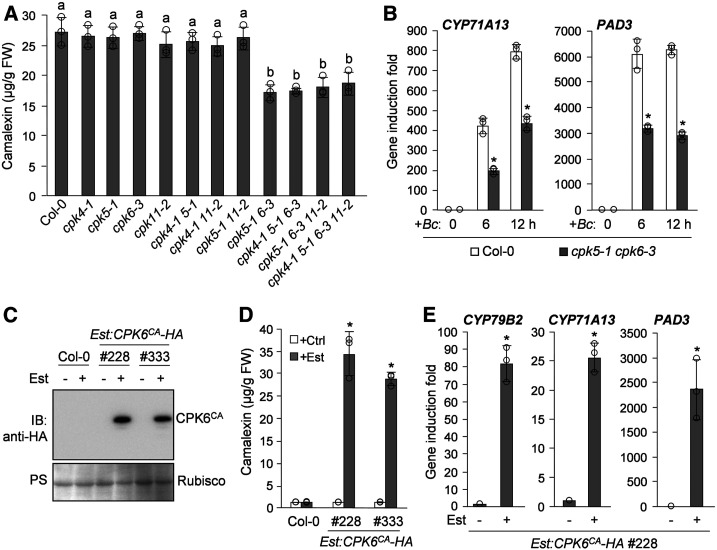Figure 2.
CPK5 and CPK6 Redundantly Regulate Camalexin Biosynthesis.
(A) CPK5 and CPK6 play redundant roles in B. cinerea-induced camalexin biosynthesis. Camalexin produced from 2-week-old Col-0 and cpk mutant seedlings was measured at 24 h postinoculation with B. cinerea spores. Error bars indicate sd (n = 3 biological repeats), small circles represent individual data points, and different letters above the columns indicate significant differences (P < 0.05), as determined by one-way ANOVA. FW, fresh weight.
(B) Requirement of CPK5 and CPK6 in B. cinerea-induced expression of camalexin biosynthetic genes. Two-week-old Col-0 and cpk5-1 cpk6-3 seedlings were inoculated with B. cinerea spores. Transcript levels of CYP71A13 and PAD3 at the indicated time points were analyzed by RT-qPCR. Asterisks above the columns indicate significant differences (P < 0.05) compared with Col-0 at specific time points, as determined by Student’s t test. Error bars indicate sd (n = 3 biological repeats).
(C) to (E) Est-induced expression of CPK6CA in Est:CPK6CA-HA transgenic plants induces camalexin production and activates camalexin biosynthetic gene expression. Two-week-old Est:CPK6CA-HA transgenic seedlings were treated with 10 μM Est or the solvent control (Ctrl) for 48 h. The expression of CPK6CA-HA was analyzed by immunoblotting (IB) with anti-HA antibody, and total protein loading was assessed by Ponceau S staining (PS; [C]). Meanwhile, camalexin production was quantified (D), and the transcript levels of CYP79B2, CYP71A13, and PAD3 in one Est:CPK6CA-HA line were analyzed by RT-qPCR (E). Asterisks above the columns indicate significant differences (P < 0.05) compared with the Est-treated Col-0 (D) or the Est:CPK6CA-HA transgenic line without Est treatment (E), as determined by Student’s t test. Error bars indicate sd (n = 3 biological repeats).

